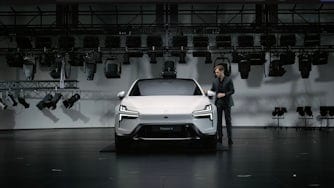Closing in on climate neutrality
We’ve been all-in from the get-go. Committed to creating a climate-neutral future and ushering in a new era of sustainable electric performance. But big announcements demand precise definitions. Without clearly defined goals, we’ll be chasing the end of the rainbow. That’s why we’re moving away from opaque definitions, spearheading a movement for transparency throughout the automotive industry.

Climate neutrality is achieved by reaching net-zero greenhouse gas emissions, balancing the emissions through removal or eliminating them altogether. This transition is crucial to help eliminate emissions from the automotive sector and unlock new opportunities.
For this reason, Polestar is aiming at climate neutrality.
However, we are not the first car brand pledging to rule out emissions. Lately, there’s been a surge of carbon neutrality announcements and companies have been lining up to declare their climate aspirations. While this is great in theory, the reality is rarely that simple.
A lot of uncertainty about what constitutes credible net-zero targets still exists, paving the way for green but opaque promises. Some companies will, for instance, include the use of offsetting through tree planting or investments in renewable energy. Though we acknowledge that third-party offsetting* can be used as a last resort to reach net zero greenhouse gas emissions and is a solution that will be necessary in the future, the current options are highly contested and don’t seem to have the suggested impact.
Even more alarming is the fact that the same companies that set ambitious targets, keep investing in ICE tech and keep putting ICE vehicles on the roads. All while scientists repeatedly emphasise that we must rapidly decline the emissions after 2020 in order to not deplete the remaining carbon budget, making it impossible to reach net zero by 2050.
We’ve had enough with greenish smoke and mirrors.
So, when we say that we work for climate neutrality, this commitment entails reducing our GHG emissions in line with the 1.5-degree pathway (as opposed to the 2-degree pathway) and use the science-based targets approach to get there. Until there are solutions with proven results in place, we view carbon offsetting as a last resort in achieving climate neutrality. Instead, our focus is on reducing the emissions we can mitigate, either directly or indirectly. This means that all parts of our value chain, including suppliers and retailers, are focused on reaching our targets without resorting to offsetting.
By utilizing innovative and circular materials, partnering with those who can help us secure renewable energy, and eliminating emissions within our supply chain, we’re taking tangible steps towards our goal.
Polestar has an ambitious strategy. We aim to say goodbye to the opaque, non-transparent ways of the traditional car industry, and reveal fresh possibilities and different ways of thinking that accelerate the transition toward climate neutrality.
We’re not out here chasing the rainbow’s end. We have a hard target. And we’re closing in.
*Third-party offsetting is defined as compensating for GHG emissions by providing emission reductions elsewhere, that would not have been realised without funding from the offsetting program.


